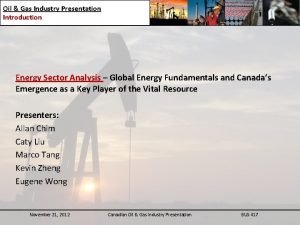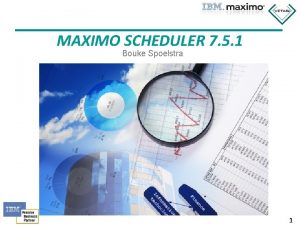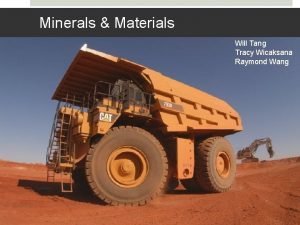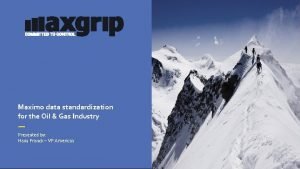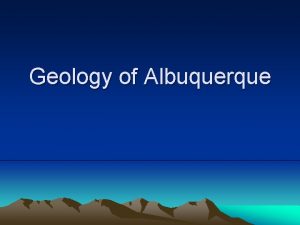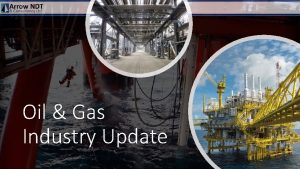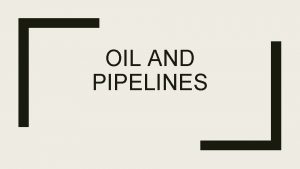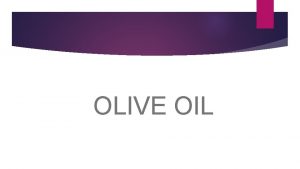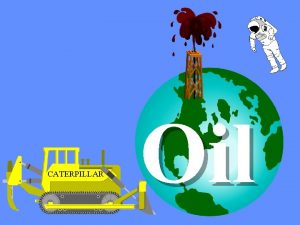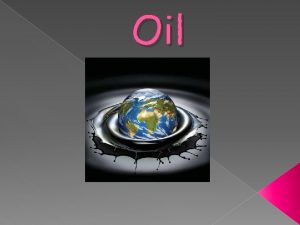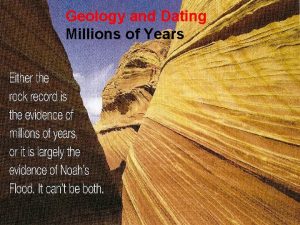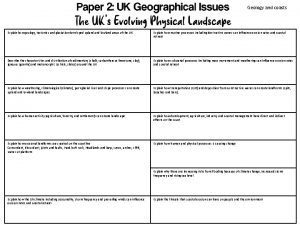Oil and Gas Geology of Oil and Gas























- Slides: 23

Oil and Gas • Geology of Oil and Gas – Similar to coal (different source) – Second most abundant liquid in the crust – Formation incompletely understood – Environments • Contain clay minerals • Subsiding depositional basins – Rapid and deep burial – Heat and pressure – Formation (biogenic to thermogenic) – Initiate migration

Geology of Oil and Gas • Movement – Primary migration – Secondary migration – Mostly found in geologically young rocks • >100 My; mostly Cenozoic or late Mesozoic (Cretaceous) – May have escaped from older rocks (preservation) • • 85% of total production comes from 5% of the fields 65% from 1% of the fields 15% of known reserves are in the Middle East Most giant fields are located in tectonic belts that have been active in the past 60 -70 My

Geology of Oil and Gas • Oil traps – Cap rock-zone of impervious rock – Anticline (70%) – Fault – Unconformity (20%) – Stratigraphic traps – Salt domes (5%)

Geology of Oil and Gas • Production – Primary recovery – Enhanced recovery – Brine disposal • Distribution of Gas and Oil – US situation – Future • • New discoveries? Maybe Coal derived processes Nuclear fuels Alternative energy sources

Natural Gas Reserves

Oil Reserves

Impact of Oil and Gas Exploration and Development • Negligible to significant • Sensitive areas • Development – – Drilling wells Disposing of waste water Transporting Converting • Use – Greenhouse gases – Urban pollution

Impact of Oil and Gas Exploration and Development • Gas Hydrates – – Recently discovered in young geologic environments “Ice crystals" of gas and water In 1997, estimate was refined to 200, 000 trillion ft 3 Greater than all oil and coal reserves.

Oil Shales and Tar Sands • Geology of Oil Shales – Oil shale • Origin similar to other petroleum materials • Sedimentary rock containing kerogen • Heating yields significant hydrocarbons – Example • Green River Formation

Oil Shales and Tar Sands • Geology of Tar Sands – Tar sands • • Impregnated with tar oil, asphalt, and other organic materials Difficult to recover by conventional methods Berea Tar Pits in California Best know in Canada at Athabasca – Distribution of Oil Shale and Tar sands • US: about 2/3 of oil shale resources • Canada's tar sands: equal of about 50% of world oil reserves – Current Economics • Getting better • Canadian dollar has risen dramatically against the US dollar; has become a true "petrodollar"

Oil Shales and Tar Sands • Impact of Exploration and Development – – – Uses conventional near surface techniques Insufficient water for processing Tar sands are in small scale production Oil shales increase in volume after retorting (20 -30%) Modified in-situ processing

Fossil Fuel and Acid Rain • Environmental Effects of Acid Rain – Damage to Vegetation – Damage to Lake Ecosystems – Damage to Human Structures • A Solution to the Acid Rain Problem

Areas Sensitive to Acid Rain

Oil in the 21 st Century • Crisis Indicators: – – Consumed 50% of available resources Rate of discovery is low Peak world recovery will by 2020 US production will end by 2090 • Responses: – Education and planning – Develop known coal resources – Develop alternative technology

Nuclear Energy: Fission and Fusion • Energy from Fission – Chain reactions • Reactor design and operation – Burner reactor – Breeder reactor (uranium cycle; thorium cycle) – Geology and distribution of uranium – Risks associated with fission reactors – The future of energy from fission

Nuclear Reactor BWR No body would build a reactor where the recirculating fluid would be in contact with the nuclear material; too dangerous!!

Energy from Fusion – Tokamak magnetic bottle – Cold Fusion (Stanley Pons and Martin Fleishman)

Geothermal Energy • Geology of Geothermal Energy – Hydrothermal convection systems – Hot igneous systems – Geopressured systems – Groundwater systems • Environmental Impact of Geothermal Energy Development – The Future of Geothermal Energy

Geothermal Energy

World Energy Resource Base Gas Hydrate not included

Renewable Energy Sources • Direct Solar Energy – Active and passive systems – Solar Cell – Ocean Thermal Energy Conversion • Water Power – Hydroelectric power – Tidal Power • Wind Power – Objections have been growing • Noise • Bird kills • Aesthetics • Energy from Biomass – Wood Wastes

Renewable Energy Sources

Policy and the Future • Conservation, Efficiency, and Cogeneration • Energy Policy for the Future – Hard Path vs. Soft Path – Sustainable Energy Policy • Technology – Hybrid vehicles (Honda, Toyota, etc. ) – Hydrogen economy – Fuel cells – Clean fossil fuel alternatives
 Primary emulsion formula
Primary emulsion formula Types of separators in oil and gas industry
Types of separators in oil and gas industry Scott can industries
Scott can industries Oil and gas process simulation software
Oil and gas process simulation software [email protected]
[email protected] Maximo assignment manager
Maximo assignment manager Gomaximo
Gomaximo Madagascar oil and gas
Madagascar oil and gas Deloitte webmail outlook
Deloitte webmail outlook Hitachi vantara oil and gas
Hitachi vantara oil and gas Risk management case study oil and gas industry
Risk management case study oil and gas industry Drops oil and gas
Drops oil and gas Uses of oil and gas
Uses of oil and gas Atb oil and gas
Atb oil and gas Stc devices
Stc devices Osu oil and gas accounting conference
Osu oil and gas accounting conference Maximo oil and gas scheduler
Maximo oil and gas scheduler Maximo oil
Maximo oil What is an energy role
What is an energy role Oil and gas
Oil and gas Oil and gas revenue accounting basics
Oil and gas revenue accounting basics Costless collar oil
Costless collar oil Oil and gas company
Oil and gas company Maximo for oil and gas
Maximo for oil and gas




